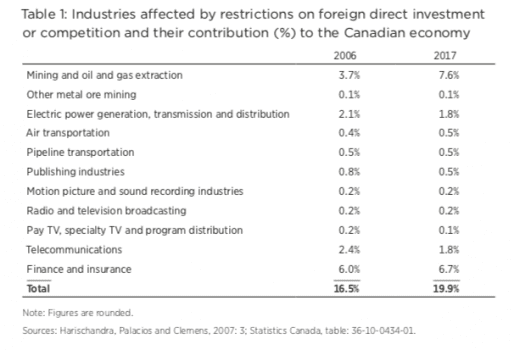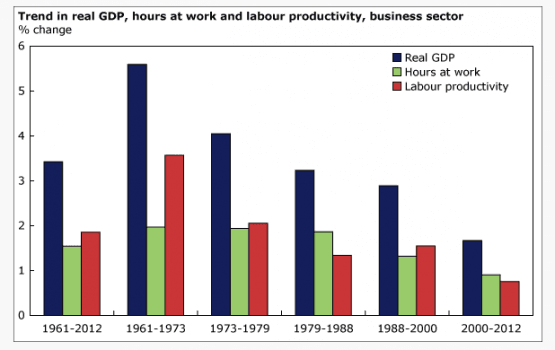NEWS ANALYSIS
Recent analyses of Canada’s competitiveness show a worsening trend. The elephant in the room is an onerous tax regime, but many other factors play deleterious roles, like anemic foreign direct investment (FDI), inadequate spending on research and development, and a high regulatory burden.Compounding the predicament is the lack of domestic competition. Canada protects dominant firms in certain sectors from competition by erecting barriers to entry. Its federal and provincial governments either own or are heavily involved in controlling several industries.
“We’ll accept less growth if we have more stable companies that don’t fail,” said Carleton University business professor Ian Lee in an interview.

“The threat of entry is the strongest disciplinary force that exists for firms to cause them to improve the quality of products and the cost of producing these products,” Geloso said in an interview. “Absent this threat, there are really very few incentives to try to improve the quality of the service.”
For example, most of the electricity production and distribution in Canada is owned by governments—firms like Ontario Hydro and Hydro Quebec have no competitive pressures, no incentives to try to improve service and find efficiencies, says Geloso.
And then there are the telecoms and airlines—notoriously well protected from new entrants.
Profits of the five biggest telecoms in 2017 totalled nearly $7.5 billion, with profit margins over 38 percent, points out Brian Masse, NDP critic for innovation, science and economic development. Canadians pay among the highest prices for wireless and broadband across OECD countries, while non-Canadian firms can’t enter the cellphone and television markets.
“Bell, Rogers, and Telus received close to $50 million in subsidies and more than $700 million in contracts from Justin Trudeau’s Liberal government,” Masse said in a press release.
Regarding the airlines, non-Canadian carriers are barred from carrying passengers between Canadian cities.
Scoring Poorly
In the 2019 IMD World Competitiveness Rankings, Canada fell three places to No. 13. This is still better than a lot of countries including Germany, Australia, and the U.K., but it’s the lowest for Canada in at least five years. The United States ranks third.Deloitte’s competitiveness scorecard for Canada corroborates. The high regulatory burden—getting a permit takes on average 168 more days in Canada than it does in the United States—has made doing business in Canada more difficult since 2006, based on the World Bank’s Ease of Doing Business rankings. Red tape serves as a moat around larger incumbent firms, as they are better able to absorb delays.
But domestically, businesses face plenty of frictions that won’t be eliminated by throwing investment dollars at the issue.
“When I’m talking with business leaders, I often hear about the costs and lost opportunities because of barriers to interprovincial trade,” Wilkins said. Other competitiveness issues she mentioned are electricity costs, the regulatory burden, and uncertainty around project approvals.
In History’s Grasp
How Canada ended up in such a quagmire harkens back to the 19th century, when it was trying to protect itself against unrest south of the border, explains Lee.Going back to Confederation, Canada has always sought to protect its economy with tariffs. It wanted a strong federal government and weaker provincial governments in order to avert the situation in the United States, where the states had too much power.
“Over the next 100 years, successive Supreme Court decisions interpreted the Constitution in the opposite direction,” Lee said. This resulted in more and more power going to the provinces, whereas in the United States, the states gradually lost power.
As the provinces gained power, interprovincial barriers to competition grew as politicians sought to protect their constituents and businesses.
“The protected sectors by the provinces have significantly contributed to our lower productivity and competitiveness,” Lee said.
Canada’s Bank Act favoured the establishment of a small number of large banks. The risk of a bank failure was minimized.

By contrast, the Americans were always suspicious of the concentration of power, including in the banking system. So, the United States has thousands of banks. “The U.S. is a viciously competitively place,” Lee said.
While Canada has been lauded for the stability of its banking system, there is a price to be paid. With a handful of big banks in Canada, they have little incentive to compete.
“We’re very averse to risk,” Lee said.
The big Canadian banks are emblematic of big incumbent companies in other industries—Bombardier, SNC Lavalin, and even GM. The Canadian ethos would not want them to fail, and so they have been bolstered by the government.
“We do it because we just think failure is anathema,” Lee said.
If an economy lacks competitive forces from within, not only does it hurt the consumer, but it also reduces productivity, which then impairs economic growth and wages.
Canada’s supply management in the dairy and poultry industries was a thorny issue in the renegotiation of NAFTA, which promotes greater competition in North America.
And with FDI, industries also get the infusion of new ideas, talent, and capital. FDI brings that threat to unseat the incumbent.
Government Fixes
The federal government is getting the message loud and clear. It has formed an external committee composed of business, academia, and consumer protection experts to improve regulatory competitiveness. It has made it a priority to encourage foreign nations to invest in Canada; as such, the Invest in Canada agency was created in 2018.But other government actions remain questionable. The Feds are attempting to pick winners—industries like agriculture and clean energy—that it feels the country has an advantage in and that should be targeted with programs and funding to take on the world.
Geloso says that this rarely works and that by doing so, the government is effectively “sending signals to that industry that they don’t need to care about consumers anymore, because they just need to care about politicians.” Bombardier is one prime example he cites.
“You have no idea where innovation is going to stem from, hence you should not try to plan it,” Geloso added.
Lee says innovation cannot be coerced, unlike physical labour at low levels of skill.
“No government coerces Silicon Valley,” he said.
Geloso’s study notes that of the 28 economies that have consistently completed the OECD survey on product market regulation between 1998 and 2013, Canada did the least to remove barriers to entry.
“Competitiveness is just a fancy word for productivity,” he said.
“The lack of competition, in my view, is intimately and inextricably interconnected with the productivity issue,” Lee said. “The more you protect your economy, the more you have a productivity problem. The less you protect your economy, the less of a productivity problem.”






Friends Read Free